A higher-priced KZ IEM with elevated aspirations. But where’s the fun in that?
It seems like only days ago that I was writing about the newest Knowledge Zenith (KZ) flagship offering, the ZS10 Pro. Not a company known for taking a deep breath and resting on their laurels, KZ is jumping into deeper water with their newest technological marvel, the AS16. They claim it has taken them 15 months to perfect this technology to provide “higher order acoustics” and “professional Hi-Fi” sound.
The AS16 features 8 Balanced Armature (BA) drivers per side, with the sound funneled through a three-channel acoustic duct structure. That’s 16 drivers delivering sound to your ears. Despite their marketing claims, can they possibly have tuned all these discrete drivers to provide a smooth and cohesive sound?
- Fast and lively sound.
- Analytical and engaging presentation leads the listener to “I never heard that in the song before” moments.
- Excellent build quality and very attractive design.
- Premium fit and finish.
- Somewhat large size so fit may be an issue for those with very small ears.
- 7-8 dB boost at 1KHz frequency may add clarity, but at the expense of smoothness.
- Lack of low bass extension.
- Y-Split is too far down the cable leading to tangling.
KZ hasn’t been known for balanced sound in their budget models. They have produced many models that are unforgivingly v-shaped, but there have been great improvements in delivering a more-balanced sound in the recent higher-end models (AS10, BA10, and ZS10 Pro).
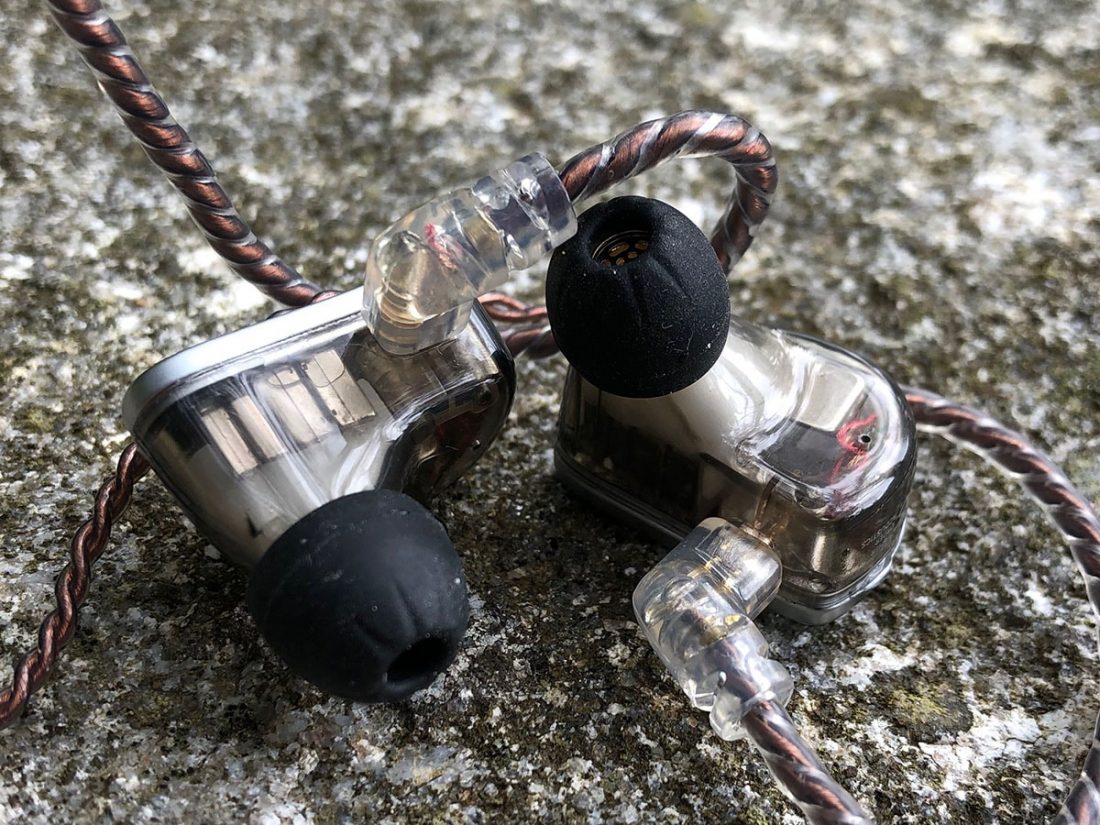
Since it seems that I am reviewing KZ IEMs on a fairly regular basis, let’s get our customary company introduction out of the way.
KZ Overview
KZ was founded in 2008 by classical musician Zen Li and former Audio-Technica engineer Keith Yue. It is a public brand for the Shenzhen Yuanze Electronics Company located in Guangdong China.
KZ has generated a huge amount of industry buzz by creating products that have seriously redefined the ratio of price to performance. There have been seemingly unending hype over KZ (as of writing: approximately 3000 pages in a single Head-Fi post). The caveat? Most discussions conclude with the idea that although their IEMs may not produce the absolute best sound, they are difficult to beat at the low price point.
Recently, some of their newer models, both more technologically advanced and correspondingly higher priced, have elevated the brand as a mainstream competitor. However, KZ has received criticism for copying the design and form factor of high-end models from Campfire Audio and Audio-Technica.
KZ IEM Series
KZ is also known for releasing many different models, so it gets convoluted when trying to figure out their hierarchy of IEMs. In a nutshell, the KZ offerings include the following series:
- AS – AS6, AS10, AS16 (balanced armature drivers – # denotes total drivers)
- AT – ATE, ATES, ATR (single dynamic driver)
- BA – BA10 (balanced armature drivers – # denotes total drivers)
- BT – BTE (hybrid BA and dynamic drivers – Bluetooth)
- ED – EDR2, ED4, ED7, ED9, ED12, ED15, ED16 (typically a single dynamic driver – ED15 and ED16 are hybrid)
- ES – ES3, ES4 (hybrid – 1 BA + 1 dynamic driver)
- HD – HDS3, HD9 (single dynamic driver)
- ZS – ZSA, ZSE, ZSN, ZSN Pro, ZSR, ZST, ZST Pro, ZST Colorful, ZS1, ZS2, ZS3, ZS4, ZS5 (v1 and v2), ZS6, ZS7, ZS10, ZS10 Pro (ZS1-3 and ZSE are dual dynamic driver, other ZS are hybrid)
CCA
To further complicate things, KZ has recently started releasing IEMs under another brand name as well. Clear Concept Audio (CCA) is a sister brand, and have released similar (sharing components, technology, design, ear tips etc.) but slightly different products than the KZ brand, targeted at the same budget IEM market. From my point of view, this further dilutes the product lineup and creates even more consumer confusion.
CCA IEMs
· CCA C04 – Hybrid – 1 BA + 1 DD. Similar to the KZ ZSN Pro housing design. Again # denotes total number of drivers per both IEMs.
· CCA C10 – Hybrid – 4 BA + 1 DD. Similar to the KZ ZSN housing design and the ZS10 driver lineup (but with a different dynamic driver).
· CCA C16 – 8 BA. Similar to the AS10 housing design. 2x 22955 bass BA, 2x 29689 midrange BA and 4x 30095 treble BA per side. Differs from AS16 which uses 4x 31736 treble BA.
The C10 and C16 share a different cable from KZ products. The CCA cable is copper colored and has knurled aluminum 2-pin plugs for the IEMs, rather than the KZ standard rubber and plastic end boots.
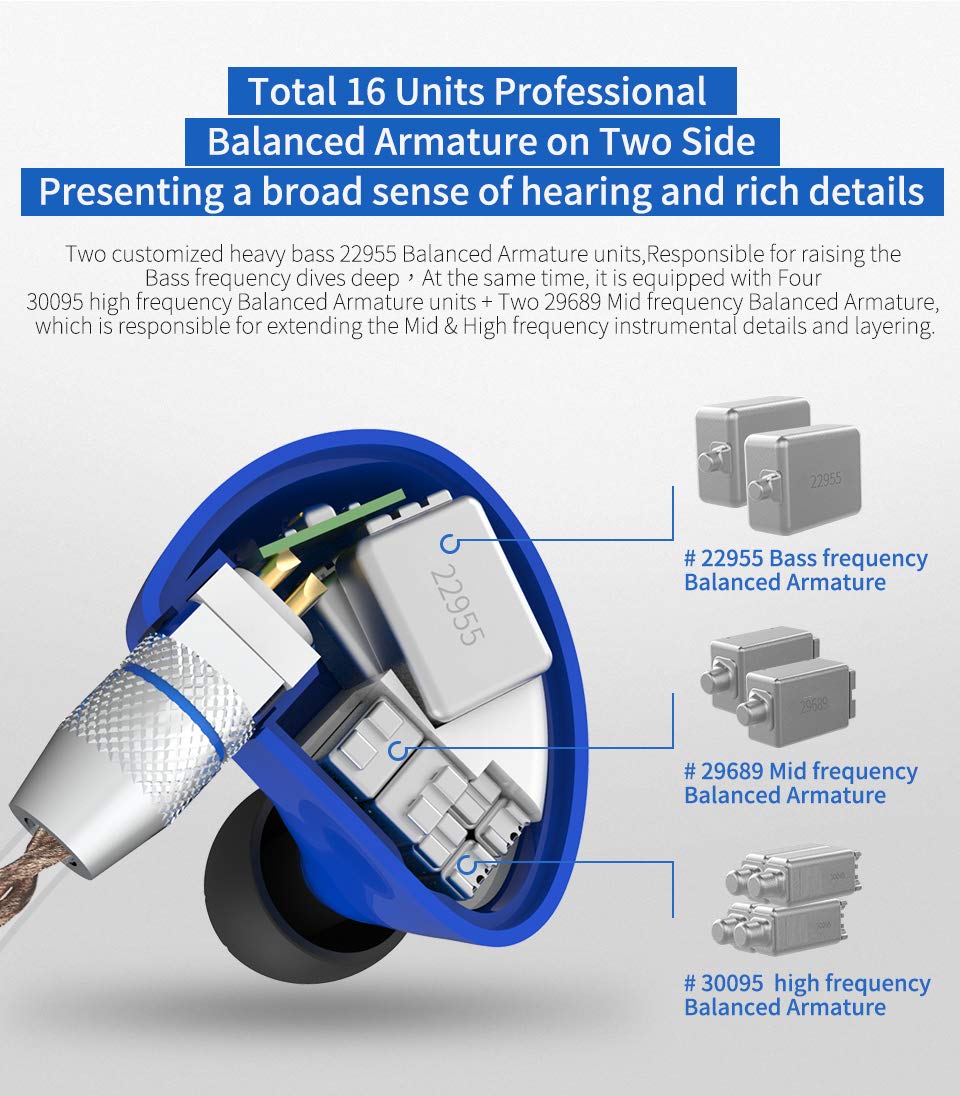
The CCA C16 was released first and is clearly a precursor to the AS16. It shares the same midrange and low frequency balanced armature driver numbers, although KZ does list the AS16 drivers as being “custom version”. The 4 high-frequency drivers differ:
- 30095 in the C16
- 31736 in the AS16.
External shape and internal structure differ slightly as well.
The Challenge of In-Ear Monitor Reviews
I’d like to add a caveat. IEMs are notoriously difficult to review and compared to full-size headphones, it is problematic to trust that review findings will be applicable to all readers.
While the size of one’s ear may impact comfort or sound of a full-size headphone, small details like the inner shape of a reviewer’s ear and the fit of an IEM greatly impacts not just the listener’s comfort, but dramatically changes the perceived performance of an IEM.
This is compounded by the plethora of ear tip sizes, materials, and shapes (which may or may not be included with the IEM) all of which uniquely fit different people. Most significantly, the quality of the ear tip seal within the ear changes the sound. So, beware dear reader, what suits one reviewer may not be applicable to you.
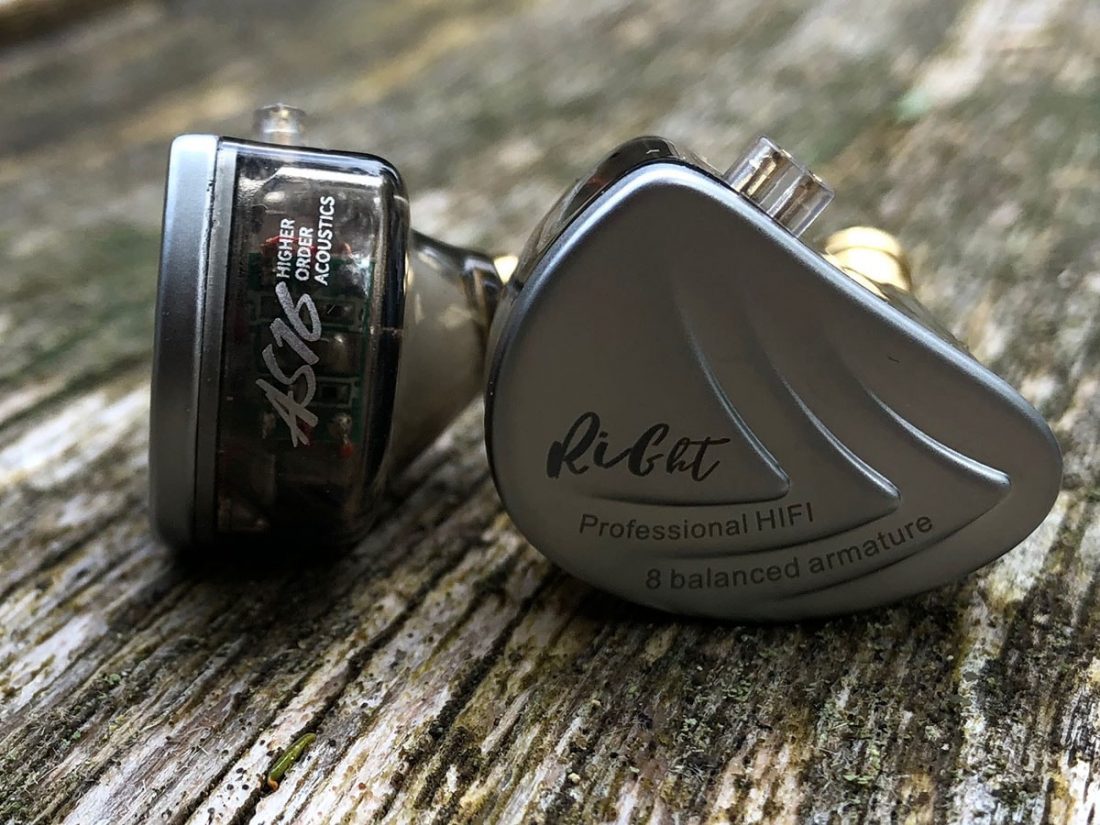
AS16 Technical Specifications
- High frequency driver: 31736 custom version balanced armature x4
- Mid frequency driver: 29689 custom version balanced armature x2
- Low frequency driver: 22955 custom version balanced armature x2
- Frequency response: 20-40000 Hz
- Sensitivity: 105dB
- Impedance: 15Ω
- Weight: 33±3g
- Colors: Translucent black or translucent blue
- Cable length: 1.25m
- Cable material: OFC Oxygen-Free Copper
- Pin type: 0.75mm gold plated
- Plug type: 3.5mm gold plated
AS16 Pro Packaging and Accessories
The AS16 presents a new revision on the traditional KZ packaging. Typically, KZ IEMs come in a small, white cardboard box. Recently, the AS10 and BA10 were packaged in a fancier, larger black book-cover style box with a metal nameplate inside. The AS16 takes the middle ground with a small box, but in the black book style with metal nameplate.
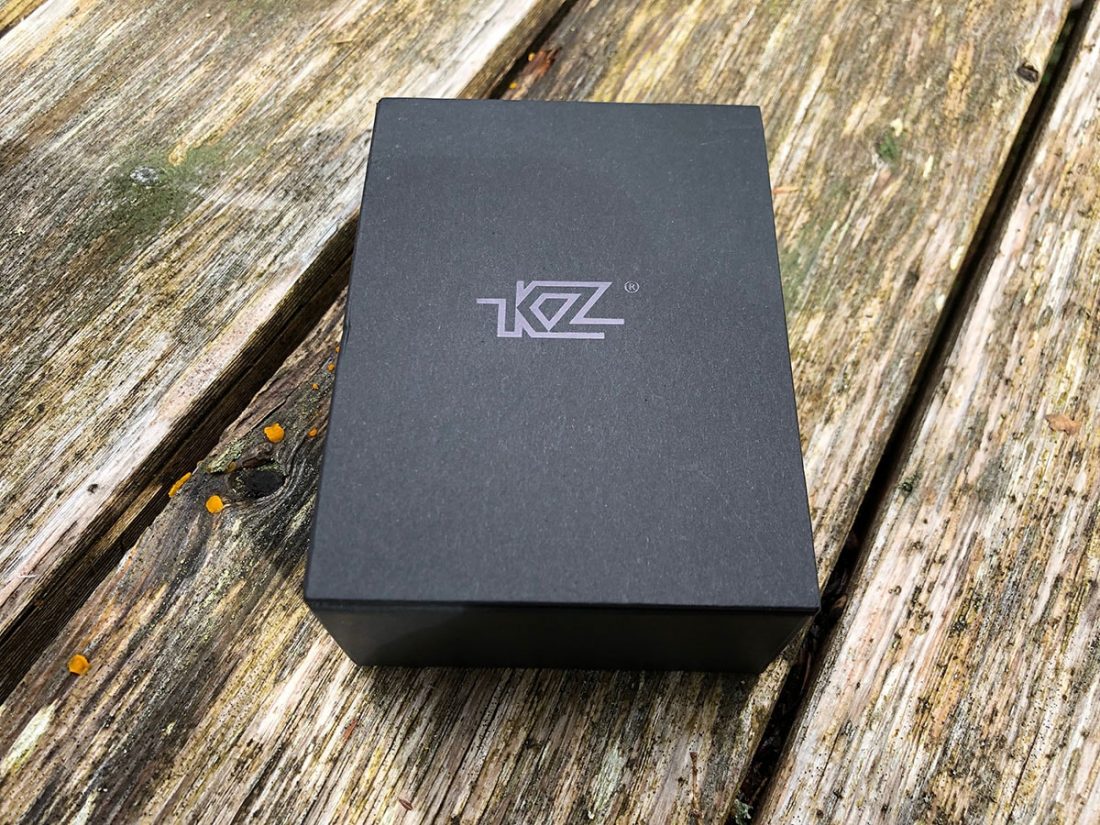
What hasn’t changed is the very minimal included accessories. Here’s what you get in the box:
This isn’t an impressive array of included accessories for a $25 IEM, let alone for one at more than 5 times the price. At this new higher price point, I simply expect more.
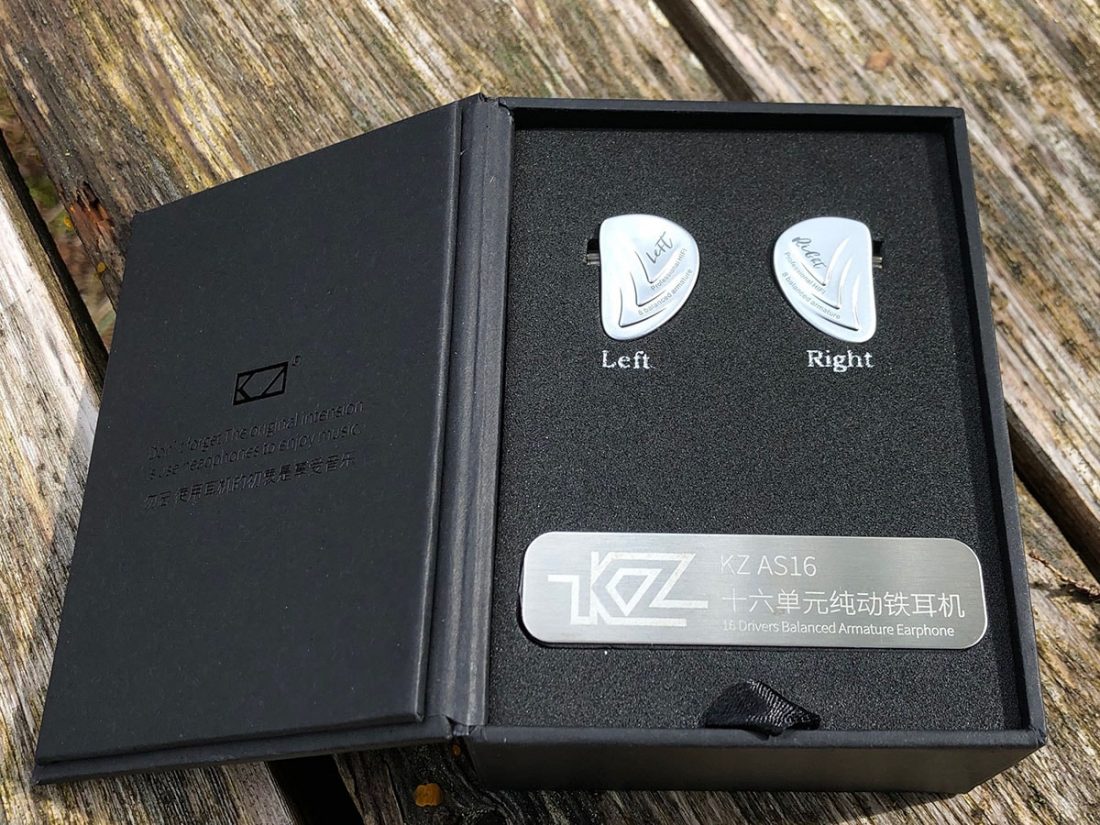
Cable
Admittedly, I’m generally a fan of the KZ cable. The bronze braid is attractive and has proven fairly robust and comfortable. There are 3 inches of clear rubber tubing at the IEM pin end that shapes the cable and holds it around the ear. Just like previous models, the Y-splitter is too low down the cable which tends to worsen tangling when not using the IEMs.
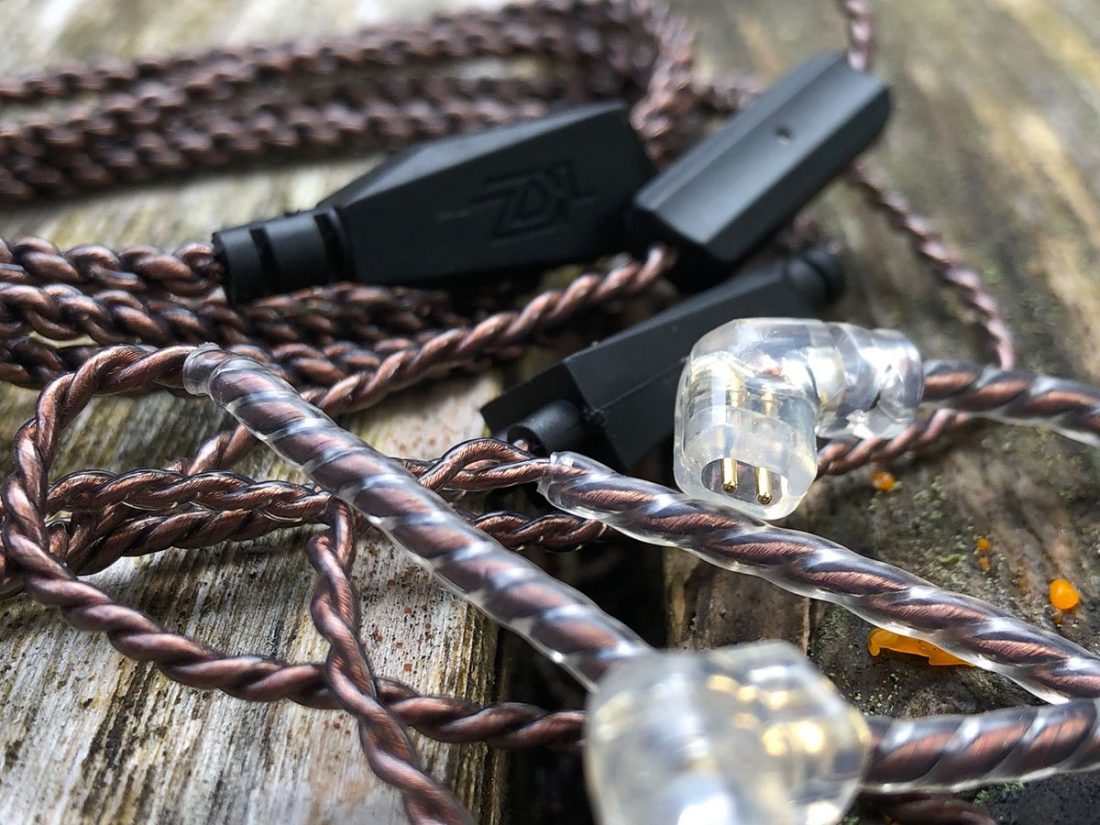
This is the identical cable packaged with the ZS10 Pro and features the newly designed recessed cable connector that pairs with the protruding sockets on the body of each IEM (also used on the ZSN and ZSN Pro). It’s sturdy and effective. Let’s just hope they stick with this single standard going forward.
Ear Tips
At the sake of repeating myself, the AS16 comes with the medium sized black silicone ear tips installed. Also included are small and large sizes in a small plastic bag, and… that’s it! The ear tips are basic but I find them comfortable and they provide a decent seal in my ears. KZ claims 26 dB of noise reduction.
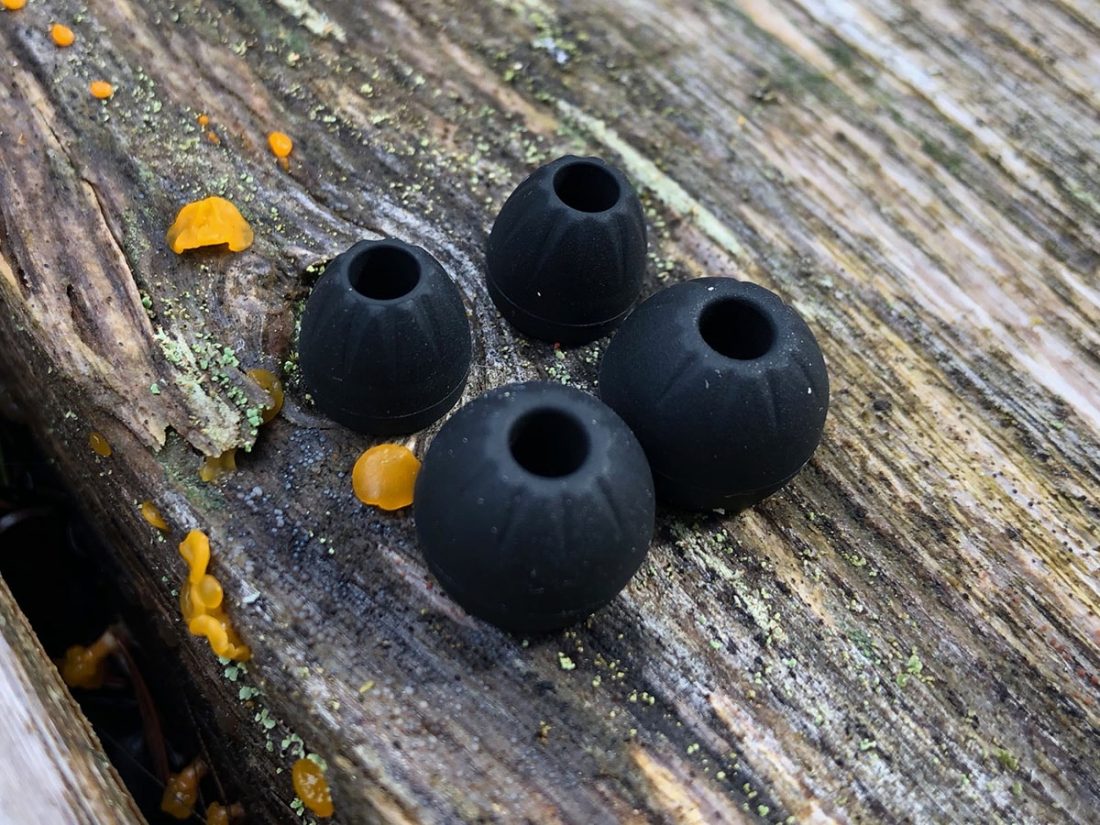
AS16 Build Quality
Once manufacturers find something that is popular and works well, the safe choice is to make everything more or less in this single design. For IEMs, this likely makes sense, as they have to fit the ear, and deviations from this basic design (I’m looking at you BA10) tend to be far less comfortable. Body color and face plate material appears to be the last bastion of individuality.
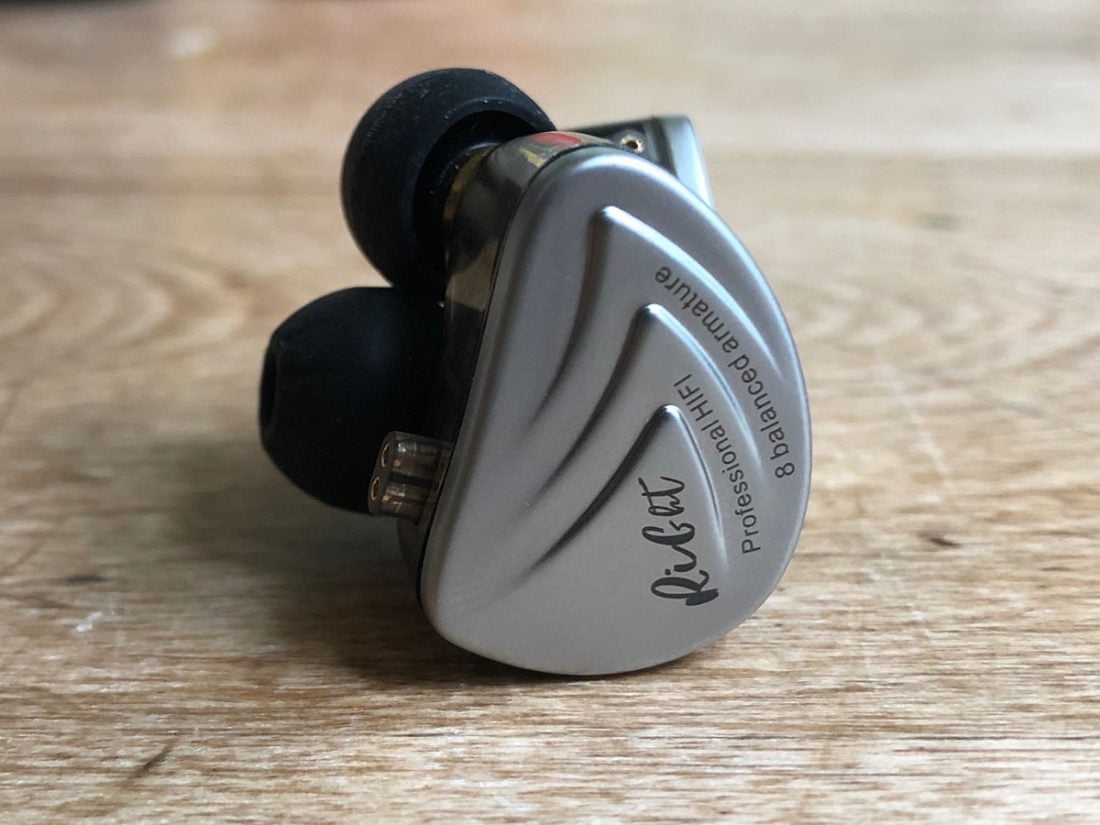
Regardless, the AS16 is a familiar large half-moon of acrylic resin available in translucent blue or black. The outside plate is a silver, fingerprint resisting, brushed zinc alloy plate held in place with no visible screws. It is adorned with three raised wave shapes that bear a striking resemblance to the forehead ridges of an alien crew member on the Orville TV show.

Each IEM has “left” or “right” printed in a perplexingly ornate script on the plate. Underneath “Professional HIFI 8 balanced armature” is printed in a standard clear font. On the rounded end of the shell is written “AS16 HIGHER ORDER ACOUSTICS”.
KZ describes the design of the AS16 as “light luxury” and to be honest, the fit and finish is smooth and basically impeccable. The same brass colored metal nozzles from the ZS10 Pro are used again, and feature a raised end ridge for ear tip retention. The metal mesh screen inside the nozzle is unique, with larger and differently shaped holes. I’m happy to report the metal screen in the ZS10 Pro has stayed in place, unlike the BA10 model, and I expect the same from the AS16.
The AS16 is attractively built, feels robust and durable in hand. The materials and construction feel appropriate for the over $100 price tag, however, are essentially identical compared to the ZS10 Pro at less than half the price.
I weighed both the ZS10 Pro and AS16 and found the AS16 to only be 1 gram heavier per IEM (9g vs 8g). As a comparison, a single (all plastic construction) AS10 weighs 5 grams. All measurements were taken with medium ear tips in place.
Driver Configuration
The internals of the AS16 is visible through the translucent resin and I can’t help but marvel at the tiny crossover board, wires and all those balanced armature drivers discernible inside. The sound is channeled through what KZ calls an “acoustic duct” structure. Three 3D printed acoustic ducts (one each for high, mid and low frequencies) channel the sound from the drivers to the ear.
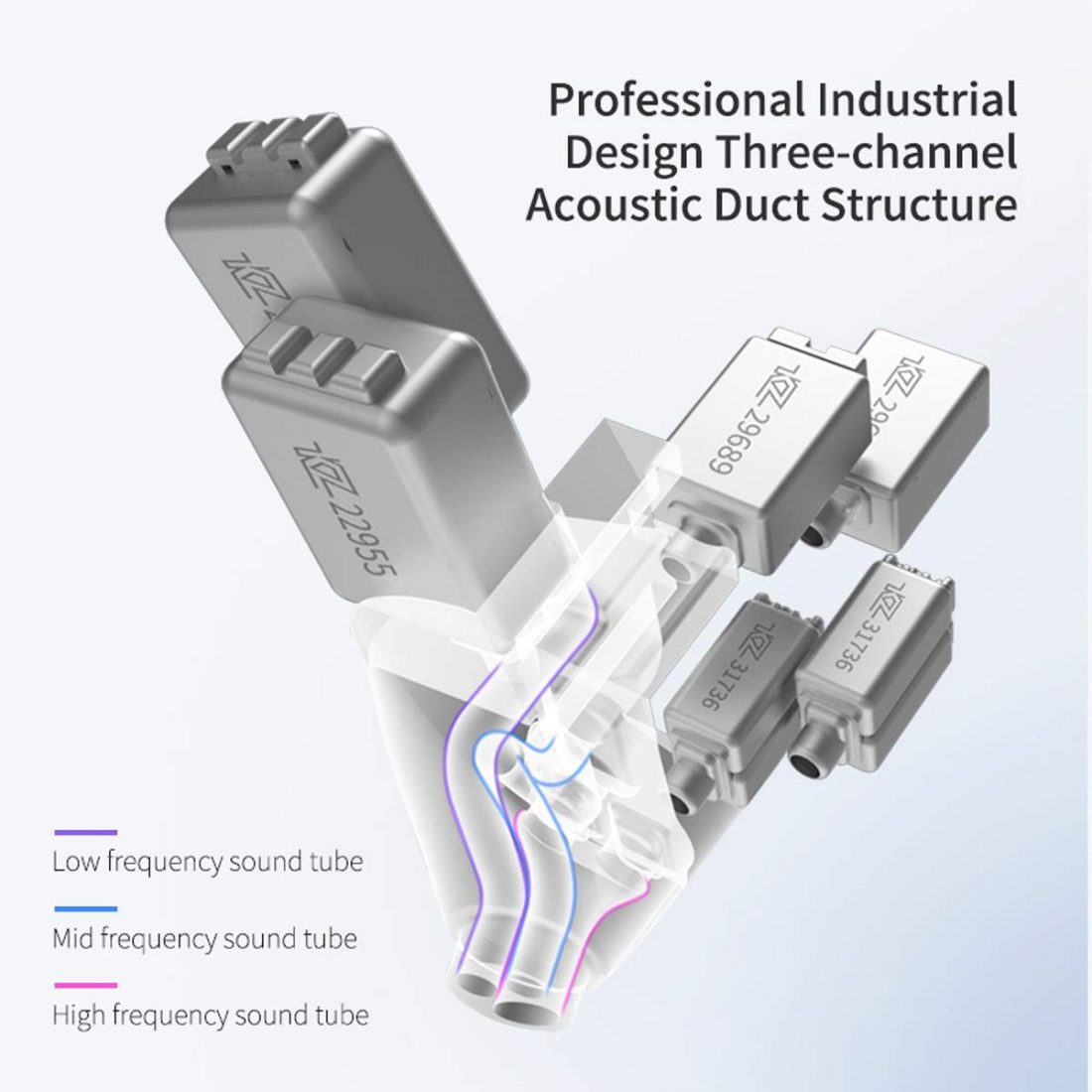
As noted above, the 8 ‘custom version’ drivers per IEM include four 31736 high-frequency BAs, two 29689 mid-frequency BAs and two 22955 low-frequency BAs. All are set back from the nozzle and use the acoustic ducts to transfer sound. The low-frequency BAs are physically larger and are mounted perpendicular to the mid and drivers.
In some KZ advertisement pictures, the custom version of the drivers is explained:
Low-Frequency Driver
Mid-Frequency Driver
High-Frequency Driver
Comfort
Comfort is going to come down to the size of your ears. The shell is smooth, rounded and nicely curved, but the size of the AS16 is simply on the larger side of the spectrum to accommodate all those drivers. It’s noticeably larger than the ZS10 Pro and the same size as the AS10, so those with tiny ears may encounter difficulties. My small-medium ears had no issues with long term usage and I found fit and comfort to be very good.
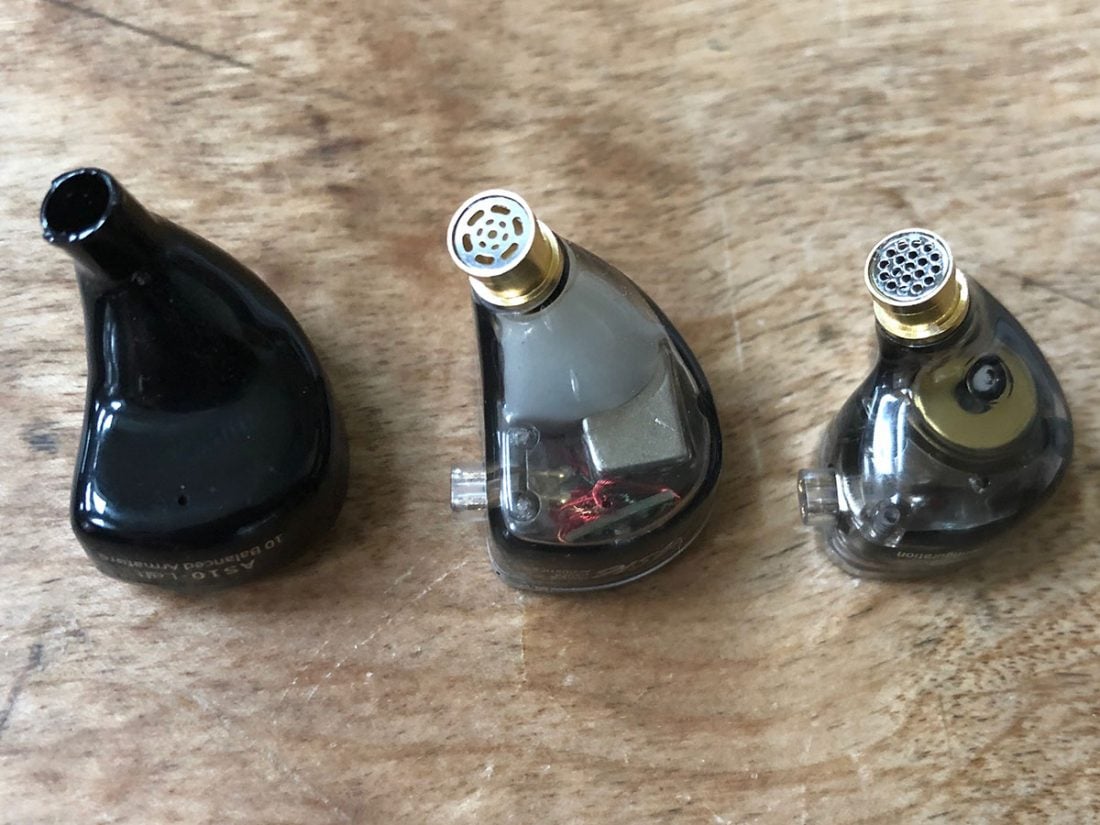
Since packaging, accessories and build quality aren’t going to differentiate the AS16 from the current best of KZ’s lineup (namely the ZS10 Pro and AS10), it’s going to have to come down to sound quality. Let’s see how it compares.
AS16 Sound Quality
I tested the AS16 with a variety of sources ranging from directly from my Apple iPhone X dongle, to using the JDS Labs C5D and from the Hagerman Audio Tuba desktop amplifier. The AS16 is efficient and easy to drive from virtually any source and any perceived sound quality differences likely come down to source more so than amplifier power. As is my habit, music choices varied widely in quality and genre.
To best interpret the sound of the AS16, we need to set our expectations appropriately. I said it before and I’ll say it again, this is no longer an ultra-budget IEM and sound quality expectations must be higher than with previous models. The AS16 costs more than twice any other KZ model.
The magic of a multi-BA IEM is in the mix. How well do the matching of the individual balanced armature units and the function of the crossover blend the sound into a harmonious amalgam? More drivers aren’t necessarily better as it offers additional opportunities to make a mistake in this balance.
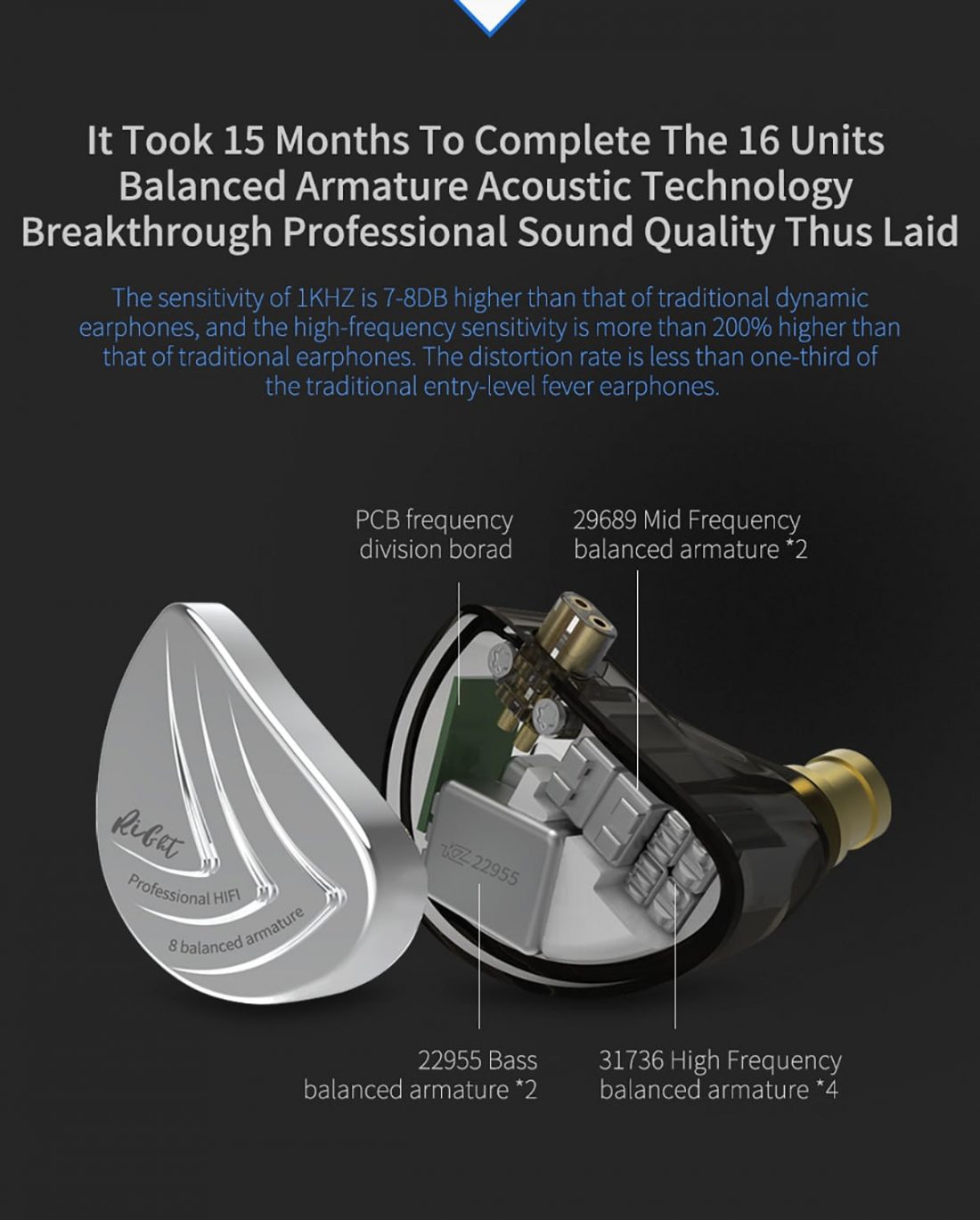
Another factor to consider is the intended usage of the product. While KZ gives hints towards their intent using words like “higher-order” and “professional” on the AS16, this quote from their promotional material is enlightening:
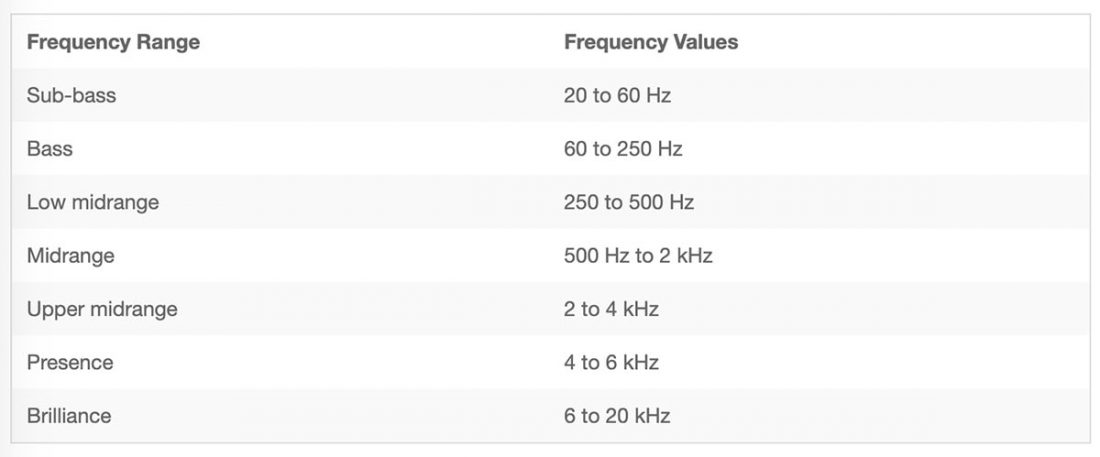
This means the higher portion of the midrange frequencies is significantly boosted. This is not a v-shaped sounding headphone. In fact, performance is quite rolled off (which is often the case with all-BA designs). With 4 high-frequency drivers and a boosted midrange, the AS16 is much more a critical listening IEM than any of KZ’s previous offerings. It’s bright, clear and fast sounding.
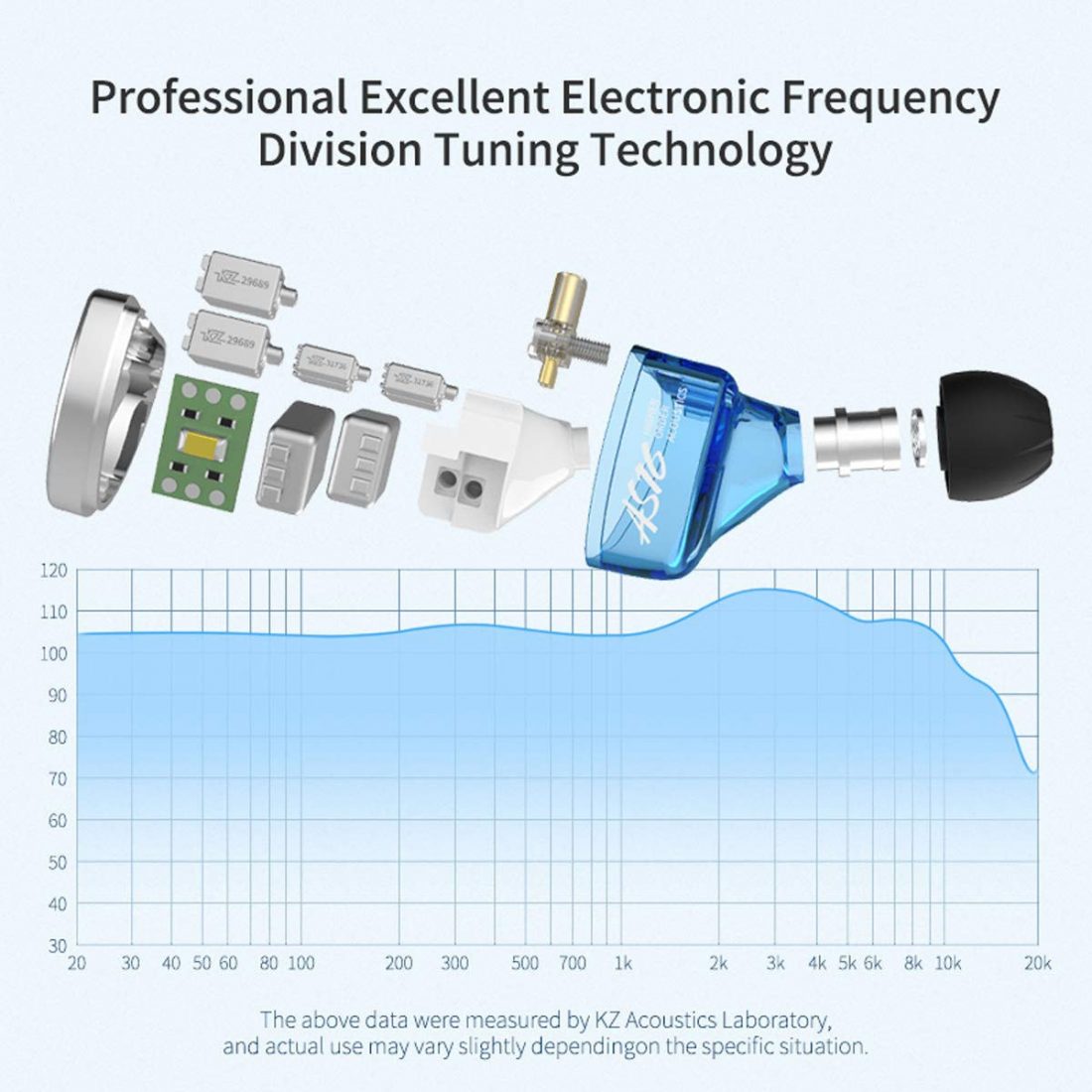
Bass
Transients are as fast as you would expect with an all BA design. However, also as you may expect, the bass performance doesn’t reach down to extended low bass frequencies. If you prefer clean and controlled bass, and not so much big and punchy, the AS16 may be what you are looking for.
The bass performance is tight, at the expense of extension, and if you go into your listening of the AS16 with that expectation, you will likely be satisfied with the quality (if not the quantity) of the low end. In the full-sized headphone world, think more of the Beyerdynamic T1 sound than the Sennheiser HD600.
Midrange
As noted, KZ intended to boost the 1 KHz midrange frequency of the AS16. This has the tendency to make voices and guitars jump out a bit in the mix. It’s a mixed blessing, as this emphasis is engaging and yields the impression of increased detail, but perhaps comes across a bit less smooth than expected.
Overall, I felt that vocals remained natural sounding and that instrument separation and the sense of space is quite remarkable in these IEMs. The AS16 has a much wider, less center-of-head, pinpointed sound than some other IEMs I’ve tried.
Treble
Unsurprisingly, 4 high-frequency BAs provide lots of treble energy, detail, and presence. What is more surprising, is that somehow the AS16 avoids excessive sibilance. Don’t get me wrong, there is LOTS of treble going on, but thankfully it is fairly high-quality and can best be described as bright.
Excessive high volume or more aggressive metal rock music may become taxing for longer listening sessions, but at moderate volume, I found myself in that pleasant “hearing things in the music that I’ve never heard before” zone. An abundance of detail and definition make for a listening experience that is more critical of the source material.
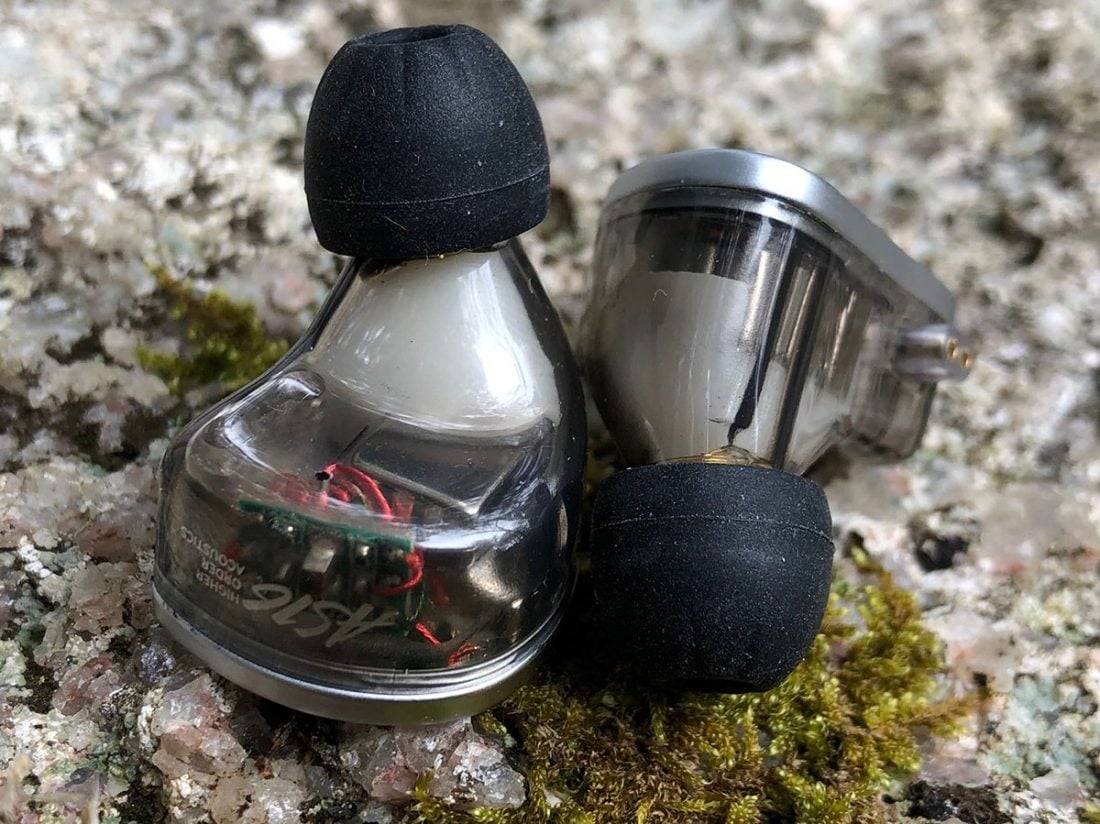
The smooth curves of the AS16.
Compared to the ZS10 Pro and AS10
While likely more technically proficient, I don’t think the AS16 is as fun as the ZS10 Pro. I prefer the warmer, fuller, and deeper bass that the hybrid design presents. The good news is, for basically the first time, KZ isn’t releasing these models to the very same market and product segment. These two products are definitely aimed at consumers with different tastes and budgets.
Clarity and detail are better on the AS16 than the ZS10 Pro. It’s simply superior at presenting midrange and high frequencies, but that comes at a price. Depending on music choice, the AS16 tends much more towards fatiguing than the warmer tuned ZS10 Pro, especially at higher volumes.
Without going into great detail, the AS16 is superior in aesthetics, detail, and resolution to the AS10. If the all BA AS10 sound signature is to your liking, you will find much more to like with the AS16. Hey, in this case, more is better!
But does it command a twice as expensive price point? Honestly, I’m torn. Where do diminishing returns begin? At $50, the ZS10 Pro delivers an excellent and oh-so-fun sound. At $135, the AS16 is less fun and more critical. It’s a matter of taste and purpose. Are you the kind of listener that focuses on the sound of the gear, the quality of the mastering, and the encoding of the source, or are you just having fun grooving out to the song?
I’m typically the latter type of listener, and consequently will reach for the ZS10 Pro more often than the AS16.
Conclusion
Is the AS16 a stepping stone into higher-end audio for KZ? Is it an experiment to see what the market will bear for price? Does it herald an evolution away from the ultra-bargain Chi-Fi offerings that made KZ popular?
It’s hard to say for sure. Certainly, the AS10, ZS10 Pro and now the AS16 is revealing a more mature and polished product lineup. They simply sound better than KZ’s previous offerings. The AS16 is a very bold move from a brand founded on low price points. With greater price, comes greater expectations, and the ‘bang-for-buck king’ moniker is much harder to achieve.
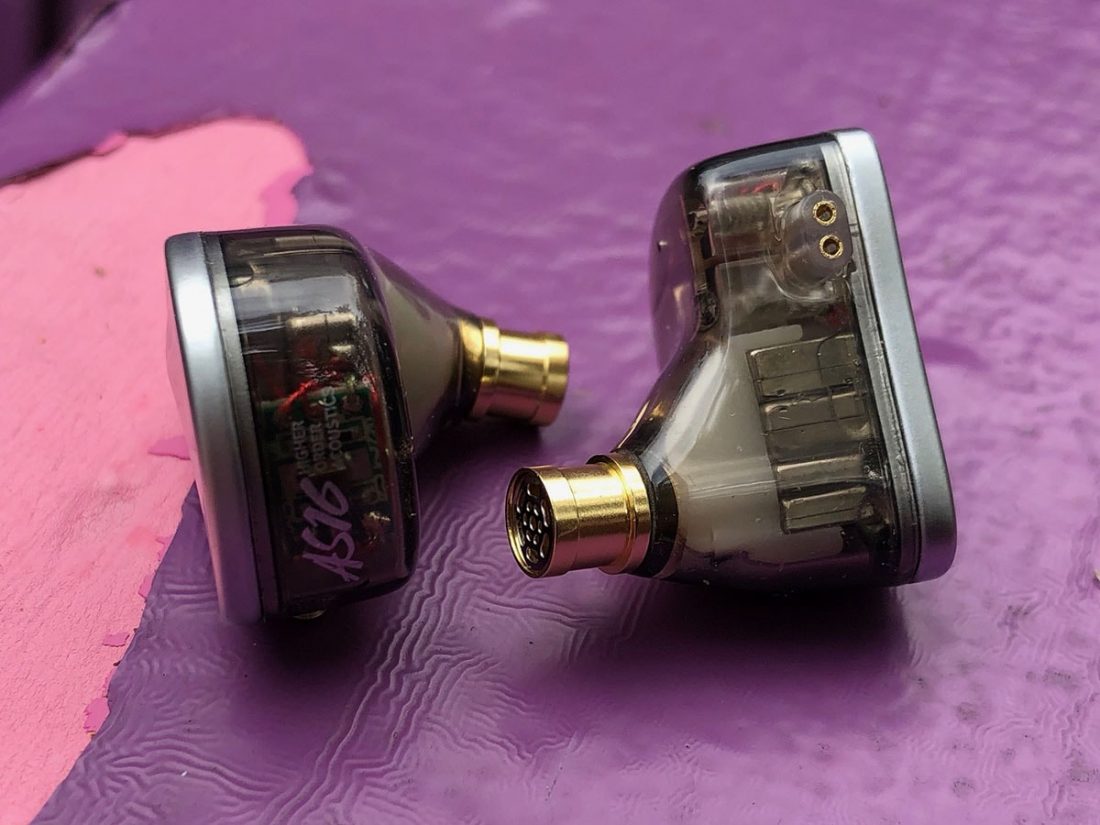
I think it is an easier path for a company to move from producing only very high-end products and begin to offer more ‘affordable’ options than to move up the quality and price ladder. KZ will need to overcome the ‘cheap’ stigma in order to be successful. To do this, they are going to need to impress on all levels: presentation, accessories, build quality, and sound quality.
Unfortunately, presentation and accessories have not significantly improved from cheaper models. Same old box, cable and ear tips, just aren’t going to be good enough to win over consumers. It seems like this is the low hanging fruit, and should be the easy way to differentiate their product lineup. Although, to be frank, product differentiation is not something KZ excels at.
Build quality is actually good enough at this price point. Impeccable fit and finish coupled with a solid, attractive design and reasonable comfort leave me with little to critique. So, perhaps as it should, it really comes down to how they sound.
The AS16 is the most technically accomplished KZ IEM to date. It provides abundant detail, clarity, and space. Really unlike any of their previous models, it is focused on critical listening and a more discerning listener. It is a true departure from the stereotypical KZ v-shaped sound signature.
But, call me an unrefined, bass-head heathen if you must, I prefer the impact, slam, and presence that the ZS10 Pro delivers. At less than half the price, I know what I’d buy.
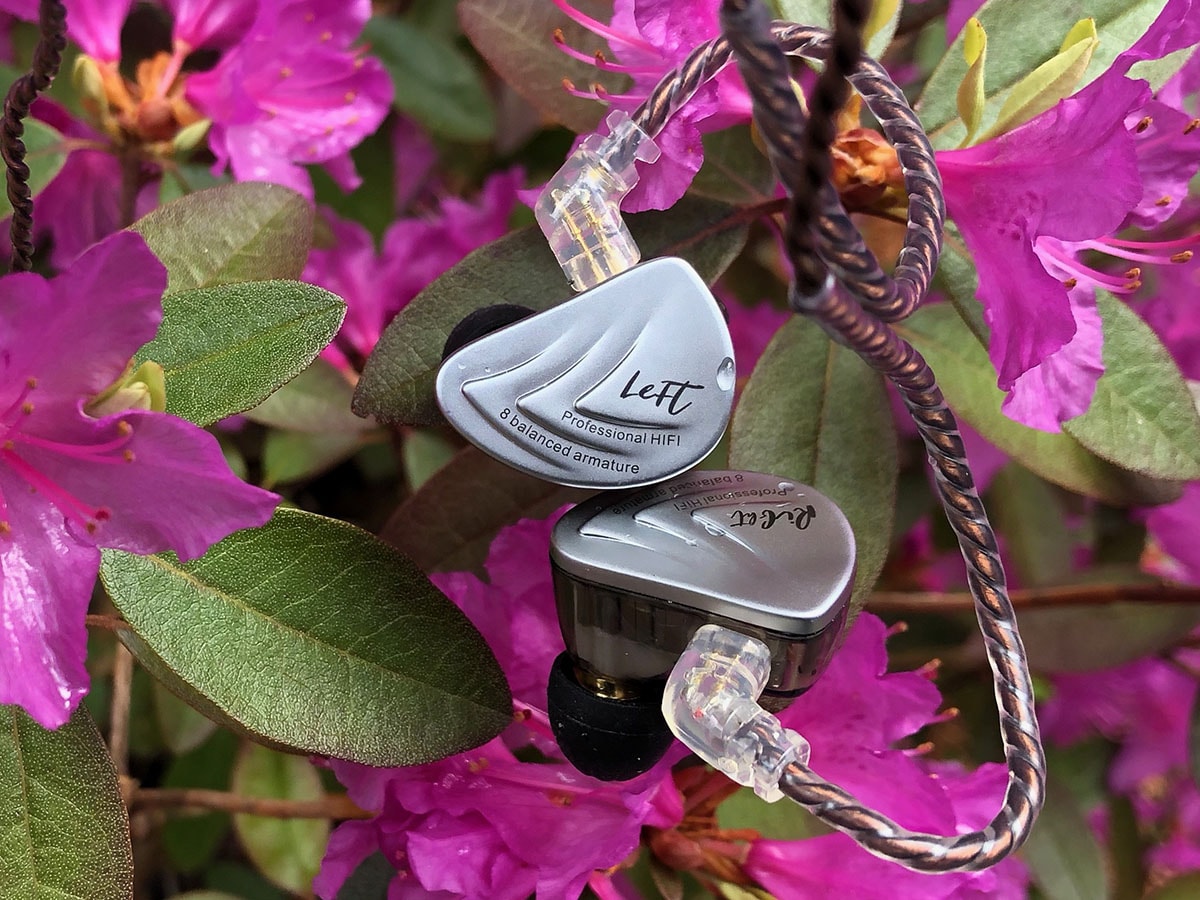

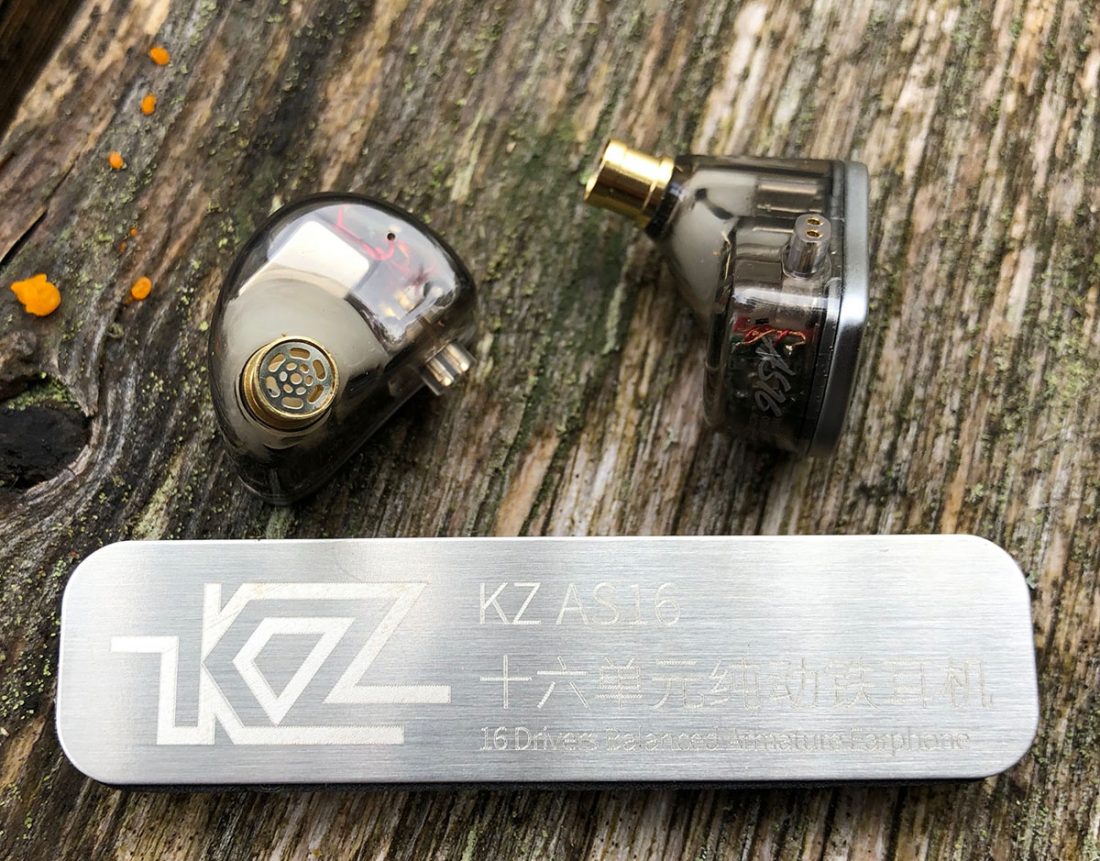
I support them testing the higher end market since it’ll give them more recognition and attract more attention but I recently got my ZS10 Pros and I love em 🙂
Recently ordered AS16 on a ~115$ sale, I was waiting for KZ 16-driver since it was teased over a year ago. BA10 used to suffice and… while I understand that garbage silicon(especially stock silicon – do NOT ever use stock KZ silicon) and even more garbage smartphone codec audio tends to make treble too heavy on the earlier models(AS10BA10), my casual setup of cheap soft foam and Cayin N3 with both amps used on 25-35 volume(which my friend calls too quiet) delivered all the frequencies, really, REALLY pure bass(I can’t stand dynamic bass anymore) and excellent “3D” sound.
Previously I used ZS10, and it also required foam tips(I was considering selling them or returning, then bought a pair, and just walked home a few kilometers, simply charmed by how much the sound changed from stock silicon to foam, that was my first experience). I liked ZS10 compared to stuff like Xiaomi HD Pro or Tennmak Crazy cello. The midrange was terrible – sharp and edgy, voice was cringy. But… the details, the soundstage – for that ~40$ they were quite good over a year ago. I hear that ZS10Pro has polished the stuff, but… they use the same drivers, particularly the mid 50060, which they abandoned virtually EVERYWHERE else, so… I wouldn’t touch ZS10Pro with a ten-foot pole. They are advertising the upcoming “6-driver hybrid teminator”, which I bet will be DD+29689+4×30095, if I know anything about KZCCA loadouts. Probably like the unofficial ZS7, which are basically AS10 with DD instead of 22955. Now that… might be interesting.
Besides, ZS10Pro is not a flagship. ZS10 was a flagship(over ZSTZS6ZS4), then there was BA10. Now there is AS16. ZS10Pro is a deprecated budgetmidrange “fun” toy with still V-sound as advertised even by KZ slides. AS12 is the BA10 high-end replacement, and I suppose 6-driver hybrid will replace ZS10Pro and would be a “budget flagship”.
Thanks for all that. Everybody has their signature preferences. My suggestion is to not write off the ZS10 Pro until you try them. 😉
Ditto! I was skeptical as well… then I bought and pair and gave them a whirl. I am a believer now. They sound fantastic. Absolutely love them!
I liked my CCA C10, with one DD and 4 BA drivers until I got the KZ AS06. The AS06 has 3 BA drivers and shows more detail than the C10. The soundstage is wider, too. Big fan.
Now I’m in a dilemma like you mentioned.
When do the diminishing returns start? Do I buy the AS16 and expect even better results?
I applaud KZ for coming this far. I remember long ago when they would come out with 2 different DD drivers in an IEM and we KZ fans were psyched. Now they’re taking on the Big Boys with multiple BAs and they have already won in my opinion.
Cant wait for my ZS10 PROs to arrive.
ZS10 PRO all the way happy camper
Mam cca c12. Które będą lepsze na scenę dla wokalisty? Jakość dźwięku, krystalicznosc, szczegółowość, można powiedzieć bardziej audiofilskie?
ZS10 Pro are good only with foam tips, otherwise there is too much going on at 6khz, while mids being reduced more than 7db and with too much at 200hz. Not a very good sound with silicone tips, however foam tips makes them very good, almost as good as cheap LG Quadbeat LE630 earphones.